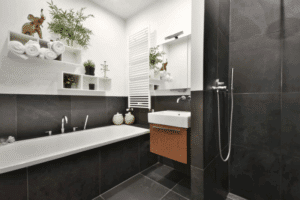Is your bathroom falling apart, and the cost to fix it feels overwhelming?
If the damage is from a covered event like a burst pipe, storm, or water leak, your homeowner’s insurance may help with the cost.
In this guide, we’ll show you how to get homeowners’ insurance to pay for bathroom remodel expenses. You’ll also learn what kinds of damage qualify and how to work with contractors and insurance adjusters right here in Windsor, CO.
Let’s dive in and turn that damage into an opportunity.
What Kind of Bathroom Damage Does Homeowners Insurance Cover?

Homeowners’ insurance in Windsor, CO, typically covers sudden and accidental damage. This could include:
- Burst pipes or plumbing issues
- Mold caused by a covered event (not long-term neglect)
- Water damage from storms or roof leaks
- Fire or smoke damage
- Structural damage from a falling tree
However, routine wear and tear, cosmetic updates, or poor maintenance won’t be covered.
Step-by-Step: How to Get Homeowners Insurance to Pay for Bathroom Remodel
1. Identify the Cause of the Damage
Insurance won’t pay for remodeling just because you want a new look. The damage must be the result of a covered peril. If you notice an issue, like leaks or mold, take photos and write down when and how you discovered the problem.
2. Review Your Policy
Look over your homeowner’s insurance policy for coverage details. Focus on:
- Dwelling coverage (Coverage A) for the structure
- Water damage and freeze/thaw damage clauses
- Mold remediation limits specific to Colorado policies
Tip: Windsor, CO policies may require separate flood insurance since standard homeowners policies typically don’t cover flooding from rivers or heavy rainfall. Be sure to review your storm damage coverage carefully, especially for hail and snow-related water damage.
3. Contact Your Insurance Company Immediately
Report the damage and file a claim as soon as possible. Delays can hurt your chances of approval. Provide documentation, including:
- Photos and videos of the damage
- Receipts for temporary fixes
- A written timeline of events
4. Get a Licensed Contractor’s Assessment
Hire a Windsor, CO licensed contractor to inspect the damage and write up an estimate. A professional report that links the bathroom damage to a covered cause can greatly support your claim.
5. Work With the Insurance Adjuster
The adjuster will visit your home to assess the damage. Be present to explain the issue and show your evidence. It’s OK to ask questions or request a re-evaluation if you feel their report is incomplete.
6. Appeal or Negotiate If Necessary
If your claim is denied or underpaid, you can file an appeal. You may also hire a public adjuster to advocate on your behalf or consult with an attorney familiar with Colorado insurance claims disputes.
Pro Tip for Windsor, CO Homeowners: Preventive Maintenance Pays Off
In semi-arid climates with cold winters like Windsor, CO, insurance companies are especially vigilant about damage from frozen pipes, snowmelt leaks, and water intrusion caused by seasonal storms. Regularly check your bathroom for leaks, ventilation issues, or aging plumbing, so you’re never caught off guard by a claim denial due to neglect.
What Homeowners Insurance Won’t Cover (Common Mistakes to Avoid)
It’s important to understand the limits of your homeowner’s insurance before assuming a remodel will be reimbursed. While certain types of damage are eligible, your claim may be denied if the cause doesn’t fall under a covered peril, or if you’ve unintentionally made one of these common mistakes:
Neglect and lack of maintenance
If mold, rot, or leaks were allowed to grow over time without being addressed, your insurer may classify it as homeowner negligence.
Cosmetic updates
Wanting a bathroom that’s newer or trendier isn’t grounds for a claim. Insurance only covers damage repair, not design upgrades.
Unpermitted renovations
Remodeling or plumbing work done without the proper Windsor, CO permits or Larimer County building permits could void your claim.
Pre-existing issues
Damage that existed before you got your current policy generally won’t be covered.
Tip: Always document repairs and maintenance over time. It shows the insurance company that you’re a responsible homeowner.
How Much of the Remodel Will Insurance Cover?
Even if your claim is approved, don’t expect your insurance to cover a full bathroom remodel. Most homeowners’ insurance policies in Windsor and surrounding areas like Severance, Timnath, and Greeley are meant to restore your bathroom to its original, pre-damage condition. Coverage typically applies to repairs resulting from water damage, mold, or structural issues, rather than luxury upgrades or design changes.
Here’s what typically affects your payout:
Deductible
This is the amount you pay out of pocket before insurance kicks in. If your deductible is $1,500 and the bathroom repairs cost $5,000, insurance would cover $3,500.
Coverage limits
Some policies cap payouts for mold remediation, plumbing damage, or structural repairs.
Like-kind materials
If your old bathroom had basic tile, don’t expect your insurer to pay for luxury marble—unless you pay the difference.
Partial vs. total coverage
Insurance may only cover the portion of the bathroom directly affected by the damage, not unrelated areas.
If you’re planning to do additional remodeling during repairs, it’s helpful to understand your bathroom renovation timeline. Ask your contractor for separate estimates to clarify what insurance will cover.
What Does Homeowners Insurance Cover?
Most homeowners’ insurance policies in Windsor, CO include Dwelling Coverage (Coverage A), which protects the structure of your home, including your bathroom, if a sudden and accidental event damages it. This is what makes it possible for insurance to cover part of a bathroom remodel in the event of certain types of damage.
Commonly covered events include:
- Burst pipes or plumbing system failures
- Fire or smoke damage
- Storm-related water damage, including from snowmelt or hail damage (e.g., roof leaks)
- Falling tree branches cause structural damage, especially after winter storms or high winds
- Vandalism or theft
Coverage generally applies to:
- Walls, floors, and ceilings
- Built-in fixtures (tubs, sinks, toilets)
- Plumbing and electrical systems
However, floods (which require separate flood insurance), gradual wear and tear, mold from long-term neglect, or cosmetic upgrades are typically excluded—unless you’ve purchased extra coverage or endorsements.
Conclusion
Understanding how to get homeowners’ insurance to pay for bathroom remodel costs can save you money when damage happens. By understanding what damage qualifies and reviewing your policy, you lay the groundwork for a strong claim. Document everything and collaborate closely with contractors, insurance adjusters, and your tile installer to increase your chances of success.
Maintain regular upkeep to prevent claim denials, and remember that insurance typically covers repairs, not upgrades. Taking these steps can help you restore your bathroom without breaking the bank.


